
| Самолеты (сортировка по:) | |||||
| Страна | Конструктор | Название | Год | Фото | Текст |
LFG Roland C.II

|
Страна: Германия Год: 1915
Two-seat reconnaissance and escort duties |
| LFG Roland - Taube - 1913 - Германия | <– | –> | LFG Roland - G.I - 1915 - Германия |
 |
J.Herris - Roland Aircraft of WWI /Centennial Perspective/ (9) |
| Roland C.ll of Kasta 8, Kagohl 2. |
 |
В.Кондратьев - Самолеты первой мировой войны |
| "Роланд" C-II, 8 эскадрилья, 2 бомбардировочная эскадра ВВС Германии, май 1916г. |
 |
В.Обухович, А.Никифоров - Самолеты Первой Мировой войны |
| LFG Роланд C II |
 |
J.Herris - Roland Aircraft of WWI /Centennial Perspective/ (9) |
| Roland C.II of Kasta 8, Kagohl 2. This aircraft may have been flown by Manfred von Richthofen because he was in that unit when this aircraft served there. |
 |
J.Herris - Roland Aircraft of WWI /Centennial Perspective/ (9) |
| Roland C.ll of Kasta 8, Kagohl 2. |
 |
J.Herris - Roland Aircraft of WWI /Centennial Perspective/ (9) |
| Roland C.II flown by Hptm. Eduard Ritter von Schleich of Schusta 28 in original configuration. |
 |
J.Herris - Development of German Warplanes in WWI /Centennial Perspective/ (1) |
| Early C.II aircraft lacked a synchronized gun for the pilot, but once this was provided, the C.II Walfisch (Whale) became a two-seat fighter, presaging the later CL-category aircraft. It used the 160 hp Mercedes D.III engine. This Roland C.II is in typical early factory finish with the name Meerkatze on the aft fuselage. |
 |
J.Herris - Roland Aircraft of WWI /Centennial Perspective/ (9) |
| Roland C.II Meerkatze of FFA 18. |
 |
J.Herris - Roland Aircraft of WWI /Centennial Perspective/ (9) |
| Roland C.II flown by Lt. Otto Czermack of Schusta 28 after a forward-firing gun was fitted in a crude mount. |
 |
J.Herris - Roland Aircraft of WWI /Centennial Perspective/ (9) |
 |
J.Herris - Roland Aircraft of WWI /Centennial Perspective/ (9) |
| Roland C.II of Lt. Rudolf Windisch of Feldflieger-Abteilung 62; it has unit-applied colors painted on the fuselage, upper surfaces, and interplane struts for camouflage. |
 |
J.Herris - Roland Aircraft of WWI /Centennial Perspective/ (9) |
| Roland C.II of Schusta 27. |
 |
J.Herris - Roland Aircraft of WWI /Centennial Perspective/ (9) |
| Roland C.II with shark mouth of Flieger-Abteilung 62. |
 |
J.Herris - Roland Aircraft of WWI /Centennial Perspective/ (9) |
| Roland C.II with shark mouth of Flieger-Abteilung 62. |
 |
J.Herris - Roland Aircraft of WWI /Centennial Perspective/ (9) |
| Roland C.IIa(Li), unit unknown. |
 |
J.Herris - Roland Aircraft of WWI /Centennial Perspective/ (9) |
| Roland C.IIa with large tail, Schusta 27. |
 |
J.Herris - Roland Aircraft of WWI /Centennial Perspective/ (9) |
| Roland C.IIa with large tail of an unknown unit. |
 |
Сайт - Pilots-and-planes /WWW/ |
| Roland C.II prototype on the occasion of roll-out on October 24, 1915. |
 |
J.Herris - Roland Aircraft of WWI /Centennial Perspective/ (9) |
| A Roland C.II prototype rests in front of the L.F.G. factory at Adlershof. A similar photo was taken on October 24, 1915, and this photo was probably taken at the same time. An anemomenter airspeed indicator is mounted on the upper left wing for speed measurements. The aileron controls were led through the upper wing but early production aircraft ran the aileron controls through the lower wing. Although all production C.II aircraft used the 160 hp Mercedes D.III engine, at least two prototypes were tested with a 150 hp Benz Bz.III. The Walfisch design was patented by Ing. R. Richter on October 7,1915, and the Wickelrumpf technology was a closely-held industrial secret until 1918 when publicity photos of the Pfalz factory revealed some details of the process. |
 |
Сайт - Pilots-and-planes /WWW/ |
| The Roland C.II prototype on October 24, 1915. |
 |
Сайт - Pilots-and-planes /WWW/ |
| Roland C.II prototype with the 160hp Mercedes D.III engine. |
 |
J.Herris - Roland Aircraft of WWI /Centennial Perspective/ (9) |
| The first Roland C.II series production aircraft with company test pilot Hptm. Freiherr von Thuna in the cockpit on February 4, 1916.The fin and rudder were slightly increased in area compared to the prototypes, but needed to be even larger for better flying qualities, something finally addressed in the last production batch ordered from LFG. No rollover cage is fitted to this early production aircraft. |
 |
Сайт - Pilots-and-planes /WWW/ |
| The first Roland C.II series machine (4413/15) on February 4, 1916. |
 |
J.Herris - Roland Aircraft of WWI /Centennial Perspective/ (9) |
| This unarmed early-production C.II aircraft is in training service. The windows have been modified to slide down to open. |
 |
Сайт - Pilots-and-planes /WWW/ |
| Roland C.II (4437/15) |
 |
K.Delve - World War One in the Air /Crowood/ |
| The LFG Roland CII, of which several hundred were built, entered service in early 1916 as a reconnaissance aircraft but was also used as an escort fighter. |
 |
J.Herris - Roland Aircraft of WWI /Centennial Perspective/ (9) |
| A Roland C.II of the first production batch as shown by the lack of a fixed gun for the pilot and the rounded rollover cage. |
 |
J.Herris - Roland Aircraft of WWI /Centennial Perspective/ (9) |
| An early production Roland C.II shows its clean lines. April 25, 1916. |
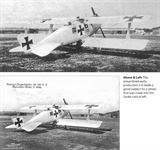 |
J.Herris - Roland Aircraft of WWI /Centennial Perspective/ (9) |
| A curious Roland C.II reconnaissance and escort two-seater biplane of 1916-17, with pilot and passenger above the upper plane. It will be noted that the "single strut" idea is not new in Germany. The engine is a 160 h.p. Mercedes D.III. Its body arrangement recalls Mr. R.F.Macfie's design of 1911. This streamlined early-production C.II made a good subject for a photo that was made into the Sanke card at left. |
 |
J.Herris - Roland Aircraft of WWI /Centennial Perspective/ (9) |
| This early-production Roland C.II has been painted with a number of dark (black?) circles for identification. |
 |
J.Herris - Roland Aircraft of WWI /Centennial Perspective/ (9) |
| An early production Roland C.II with armament supplemented by a captured Lewis on an improvised mount. |
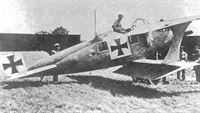 |
J.Herris - Roland Aircraft of WWI /Centennial Perspective/ (9) |
| This early-production C.II of Lt. Rudolf Windisch of Feldflieger-Abteilung 62 has unit-applied colors painted on the fuselage, upper surfaces, and interplane struts for camouflage. |
 |
Сайт - Pilots-and-planes /WWW/ |
| Roland C.II of Staffel 6 at Mont airdrome |
 |
Сайт - Pilots-and-planes /WWW/ |
| Roland C.II of Staffel 6 at Mont airdrome |
 |
J.Herris - Roland Aircraft of WWI /Centennial Perspective/ (9) |
| This early-production C.II has a dark (black?) band around the fuselage and on the fin for identification. A rack under the observer's window carries signal flares.The Roland C.II was a very photogenic airplane compared to its peers and represented a significant performance increase. |
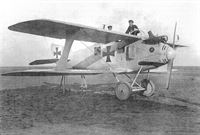 |
J.Herris - Roland Aircraft of WWI /Centennial Perspective/ (9) |
| This early-production Roland C.II shows the clean lines of this break-through design. Eyes and mouth have been painted on to emphasize the Walfisch design's resemblence to a fish. Unlike the prototypes, the early production aircraft had their aileron cables routed through the lower wing, then rising upward externally to move the ailerons. The streamlined 'ocarina' exhaust was a distinctive feature of many C.II aircraft. |
 |
J.Herris - Roland Aircraft of WWI /Centennial Perspective/ (9) |
| Perhaps in training service, this C.II has its propeller and engine covered by canvas for protection. |
 |
J.Herris - Roland Aircraft of WWI /Centennial Perspective/ (9) |
| The striking Roland C.II was a favorite backdrop for photos. |
 |
J.Herris - Roland Aircraft of WWI /Centennial Perspective/ (9) |
| A Roland C.II of Flieger-Abteilung 62 with shark mouth is photographed with its flight crew in the center (Oblt. Maximilian von Cossel at left, and to his left, Vzfw. Rudolf Windisch) flanked by its ground crew on the Eastern Front. |
 |
J.Herris - Roland Aircraft of WWI /Centennial Perspective/ (9) |
| This early-production C.II is being readied for flight. Wooden planks prevented getting bogged down in mud. |
 |
Сайт - Pilots-and-planes /WWW/ |
| C.II early production model. |
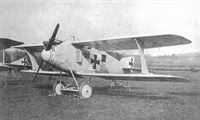 |
J.Herris - Roland Aircraft of WWI /Centennial Perspective/ (9) |
| The streamlined C.II was a notable advance over contemporary two-seaters. The care taken to minimize drag gave it a speed 30 km/h (19 mph) faster than other German two-seaters when it reached the front. |
 |
J.Herris - Roland Aircraft of WWI /Centennial Perspective/ (9) |
| The LFG Roland C II of exceptionally clean appearance made its debut in October 1915 and stayed in front-line service until the autumn of 1917. Powered by a 160hp Mercedes D II, the C II's top level speed was 103mph at sea level. Thanks to its relatively short span, low aspect ratio wings, its high altitude performance was limited to a modest ceiling of 13,100 feet. This said, it should be noted that the RFC ace, Albert Ball cites this machine as being the best of the German two seaters with very effective fields of fire to the front and to the rear. This is an early production example, serving with Fl Abt A 227 at Lille in the autumn of 1916. The crew members are Lt Stuhldreer, pilot, sitting on the inboard upper wing, along with Lt Allmenroder, observer, astride the port wheel. |
 |
J.Herris - Roland Aircraft of WWI /Centennial Perspective/ (9) |
| Portrait of an early-production C.II aircraft with the flight crew, Oblt. Maximilian von Cossel at left, and Vzfw. Rudolf Windisch second from left, either just before or after their famous raid on a Russian railway line.The ground crew is on the right. |
 |
J.Herris - Roland Aircraft of WWI /Centennial Perspective/ (9) |
| Roland C.II aircraft of the first Roland production batch. |
 |
J.Herris - Roland Aircraft of WWI /Centennial Perspective/ (9) |
| Kasta 8 of Kagohl 2 lineup with early-production C.II aircraft on the right and other aircraft on the left. |
 |
J.Herris - Roland Aircraft of WWI /Centennial Perspective/ (9) |
| Another photo of the early-production C.II aircraft of Kasta 8 of Kagohl 2. The C.II in the center of the lineup appears to be the aircraft with black circles shown on page 22. |
 |
Сайт - Pilots-and-planes /WWW/ |
| Roland C.II on March 10, 1916. |
 |
J.Herris - Roland Aircraft of WWI /Centennial Perspective/ (9) |
| An aircrew is photographed with their early-production Roland C.II. |
 |
J.Herris - Roland Aircraft of WWI /Centennial Perspective/ (9) |
| Another photo of early-production C.II Meerkatze, which means a green or long-tail monkey. |
 |
J.Herris - Roland Aircraft of WWI /Centennial Perspective/ (9) |
| Early-production Roland C.II Meerkatze of Feldflieger-Abteilung 18; some observers preferred a Lewis machine gun to the heavier Parabellum. |
 |
Сайт - Pilots-and-planes /WWW/ |
| Groschler and Patheiger of Feldflieger-Abteilung (A) 213 |
 |
J.Herris - Roland Aircraft of WWI /Centennial Perspective/ (9) |
| This early-production Roland C.II of FEA 6 was flown by Lt. Konrad von Bulow and Oblt. Tamm. The windows in the fuselage allowed more light into the cockpits and could also be used as emergency escape hatches in case the aircraft turned upside down from a bad landing or being shot down. |
 |
J.Herris - Roland Aircraft of WWI /Centennial Perspective/ (9) |
| Lt. Otto Czermack's Roland C.II was from the first production batch and lacked a synchronized gun for the pilot. Subsequently a fixed machine gun was mounted to fire above the propeller arc on a crude mount. |
 |
J.Herris - Roland Aircraft of WWI /Centennial Perspective/ (9) |
| The Roland C.II flown by Otto Czernak was equipped with an interesting instrument in the cockpits that enabled the observer to send directions to the pilot. |
 |
J.Herris - Roland Aircraft of WWI /Centennial Perspective/ (9) |
| Lt. Otto Czermack's modified Roland C.II in the snow. A fixed machine gun for the pilot has been added on a crude mount, apparently to fire over the propeller arc, to compensate for the missing pilot's gun installed on later production aircraft. |
 |
J.Herris - Roland Aircraft of WWI /Centennial Perspective/ (9) |
| The Roland C.II arrived at the front when the comparatively primitive Fokker Eindeckers were still the leading German fighters. This early production C.II lacked a fixed, synchronized gun for the pilot so was not yet a two-seat fighter, but it was faster than the Eindeckers. There is a great contrast in production technology between the two aircraft. |
 |
Сайт - Pilots-and-planes /WWW/ |
| Hptm. Eduard Ritter von Schleich in his Roland C.II. |
 |
J.Herris - Roland Aircraft of WWI /Centennial Perspective/ (9) |
| The Roland C.II aircraft assigned to Hptm. Eduard Ritter von Schleich of Schusta 28 attracts a crowd. New aircraft types always draw the curious, and the radically-streamlined Roland C.II was especially popular, gaining a reputation much larger than its small numbers at the front would indicate. |
 |
J.Herris - Roland Aircraft of WWI /Centennial Perspective/ (9) |
| Hauptmann Eduard von Schleich in his early-production Roland C.II prepares for flight on a snow-covered airfield with the obligatory dog in the foreground. |
 |
Сайт - Pilots-and-planes /WWW/ |
| Hptm. Eduard Ritter von Schleich in his Roland C.II. |
 |
J.Herris - Roland Aircraft of WWI /Centennial Perspective/ (9) |
| Hptm. Eduard Ritter von Schleich's Roland C.II. |
 |
J.Herris - Roland Aircraft of WWI /Centennial Perspective/ (9) |
| Hptm. Eduard Ritter von Schleich's Roland C.II in the snow. |
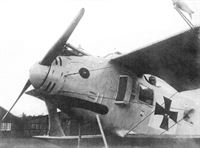 |
J.Herris - Roland Aircraft of WWI /Centennial Perspective/ (9) |
| The Roland C.II aircraft assigned to Hptm. Eduard Ritter von Schleich and others of Schusta 28. The markings of the aircraft are distinctive, as is the fish on the upper left wing in place of an anemometer. An aircraft from the first production batch, it has the early turn-over pylon and no gun for the pilot. |
 |
J.Herris - Roland Aircraft of WWI /Centennial Perspective/ (9) |
| Hptm. Eduard Ritter von Schleich's Roland C.II was from the first production batch and lacked a synchronized gun for the pilot. |
 |
Сайт - Pilots-and-planes /WWW/ |
| Roland C.II 1615/16 |
 |
Сайт - Pilots-and-planes /WWW/ |
| Roland C.II 1615/16 |
 |
J.Herris - Roland Aircraft of WWI /Centennial Perspective/ (9) |
| Roland C.II C.1624/16 of the third production batch in embarrassing circumstances. Although Idflieg required serial numbers be painted on the aircraft, Roland-built C.II aircraft are notable for not displaying their serial numbers. |
 |
J.Herris - Development of German Warplanes in WWI /Centennial Perspective/ (1) |
| The streamlined Roland C.II was, in early 1916, the best German warplane at the front. It was much faster than contemporary C-types from other manufacturers and once the pilot was provided with a synchronized gun, it was sometimes used as a two-seat fighters, presaging the CL-types. |
 |
J.Herris - Roland Aircraft of WWI /Centennial Perspective/ (9) |
| The Roland C.II “Walfisch” immediately caught the imagination and creativity of those who flew it. Many photos show fish lips or shark mouths and eyes painted on, as well as scales, or curtains painted over the windows. The crew of this C.II chose a flashy, striped finish showing they weren’t hiding from the enemy. |
 |
J.Herris - Roland Aircraft of WWI /Centennial Perspective/ (9) |
| The LFG Roland C.II was a break-through design for Roland. The exceptional streamlining for the time - it entered service in March 1916 - was developed in conjunction with wind-tunnel testing and full-size testing on a high-speed train. To reduce drag the upper wing was built directly into the fuselage without benefit of cabane struts. The C.II was the smallest, fastest German two-seater when it reached the front, and was faster than most Allied fighters. Initially armed with a single flexible gun for the observer, the second and subsequent production batches included a fixed, synchronized gun for the pilot as shown above. The speed of the C.II coupled with its effective armament made it the first German two-seater that was effective as a two-seat fighter. The relatively high-performance C.II proved a handful for many service pilots and its maneuverability and flying qualities were mediocre.The narrow gap between the wings resulted in airflow interference between them, reducing lift and increasing drag. The view upward was excellent but the view downward and forward was limited, a problem that contributed to numerous landing accidents. Lt. Seitz was the pilot of this C.II. |
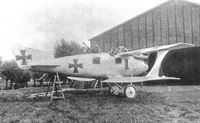 |
J.Herris - Roland Aircraft of WWI /Centennial Perspective/ (9) |
| The mid-production Roland C.II carries the light, single-color scheme originally used in production. |
 |
J.Herris - Roland Aircraft of WWI /Centennial Perspective/ (9) |
 |
Сайт - Pilots-and-planes /WWW/ |
| Roland C.II of Flieger-Abteilung 7. |
 |
J.Herris - Roland Aircraft of WWI /Centennial Perspective/ (9) |
| The mid-production Roland C.II's shown carry the light, single-color scheme originally used in production. |
 |
Сайт - Pilots-and-planes /WWW/ |
 |
Сайт - Pilots-and-planes /WWW/ |
| Roland C.IIa(Li) 1859/16 crashed at the Bayerische Flieger Schule 5. |
 |
Сайт - Pilots-and-planes /WWW/ |
| Roland C.IIa(Li) 1859/16 crashed at the Bayerische Flieger Schule 5. |
 |
Сайт - Pilots-and-planes /WWW/ |
| Leutnant Hans Joachim von Hippel's Roland C.IIa(Li) 3645/16 trainer. |
 |
Сайт - Pilots-and-planes /WWW/ |
| Leutnant Hans Joachim von Hippel's Roland C.IIa(Li) 3645/16 trainer. |
 |
Сайт - Pilots-and-planes /WWW/ |
| Fokker D.II 1533/16 and a Roland C.II 3652/16 share a hangar. |
 |
Сайт - Pilots-and-planes /WWW/ |
| Roland C.IIa(Li) 3654/16. |
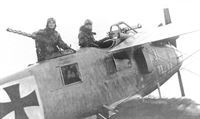 |
J.Herris - Roland Aircraft of WWI /Centennial Perspective/ (9) |
| This closeup of the mid-production C.II shown in full on page 17 shows the armament details. The observer's window has been modified to open by sliding it aft. Lt. Seitz was the pilot. |
 |
J.Herris - Roland Aircraft of WWI /Centennial Perspective/ (9) |
| The aircrew of this mid-production C.II have retained their sense of humor at the front and decorated their aircraft to suit themselves. |
 |
Сайт - Pilots-and-planes /WWW/ |
 |
J.Herris - Roland Aircraft of WWI /Centennial Perspective/ (9) |
| Mid-production Roland C.II. The Roland C.II was by far the most famous and significant Roland design. Not only is it the only well-known Roland design, for a time it was the best German aircraft at the front. Its innovative streamlining immediately made other two-seaters obsolete and its patented fuselage structure was used by Pfalz (under license) for all new Pfalz aircraft designed from the time Pfalz built Roland fighters under license. |
 |
J.Herris - Roland Aircraft of WWI /Centennial Perspective/ (9) |
| A Roland C.II of the third production version with standard tail and factory camouflage and markings for mid-production. July 1916. |
 |
J.Herris - Roland Aircraft of WWI /Centennial Perspective/ (9) |
| Roland C.IIa(Li) fitted with bomb racks. |
 |
J.Herris - Roland Aircraft of WWI /Centennial Perspective/ (9) |
| A mid-production C.II in the snow displays its dark camouflage. Unfortunately, the unit and crewmen are unknown. |
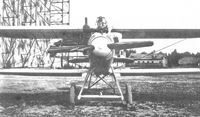 |
J.Herris - Roland Aircraft of WWI /Centennial Perspective/ (9) |
| Later production C.II with fixed gun for the pilot and bomb racks under the center section. |
 |
Сайт - Pilots-and-planes /WWW/ |
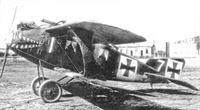 |
J.Herris - Roland Aircraft of WWI /Centennial Perspective/ (9) |
| A camouflaged Roland C.II of Flieger-Abteilung 62 with tactical number '7' painted on its fin and a shark mouth. |
 |
O.Thetford, P.Gray - German Aircraft of the First World War /Putnam/ |
| A well-decorated L.F.G. Roland C IIa. |
 |
J.Herris - Roland Aircraft of WWI /Centennial Perspective/ (9) |
| An elephant and a “whale” appear together in this photo. Hagenbeck’s Tierpark (zoo) traveled the country visiting various aviation units and schools, including the Fliegerschule at Thorn where this photo was taken to commemorate a good will visit by the animals to the student pilots and observers stationed there. |
 |
J.Herris - Roland Aircraft of WWI /Centennial Perspective/ (9) |
| A Roland C.II and a visiting elephant from Hagenbeck's Tierpark in Hamburg during a visit to the Flieger-Beobachterschule Thorn on 17 August 1917. Hagenbeck's Tierpark (Zoo) was world famous and would tour units for morale purposes with some of their animals. |
 |
J.Herris - Roland Aircraft of WWI /Centennial Perspective/ (9) |
| Roland C.II with Lt. Boes in the observer's cockpit and Oblt. Dostler at right. Lt. Boes is complaining to the Waffenmeister Lademacher at left about gun stoppage problems. |
 |
J.Herris - Roland Aircraft of WWI /Centennial Perspective/ (9) |
| This view of a Roland C.IIa(Li) shows the two-color Linke-Hoffman factory camouflage scheme applied to these aircraft.The light-colored rudder and fin are either white or light blue, a signature of C.II aircraft built by Linke-Hoffman. |
 |
Сайт - Pilots-and-planes /WWW/ |
| Linke-Hoffmann built Roland C.IIa(Li) |
 |
J.Herris - Roland Aircraft of WWI /Centennial Perspective/ (9) |
| This Roland C.IIa(Li) is ready for its next mission. The light-colored fin and rudder on a camouflaged aircraft indicates it was built by Linke-Hoffman, who built only the C.IIa version. |
 |
J.Herris - Roland Aircraft of WWI /Centennial Perspective/ (9) |
| Roland C.II aircraft of Kampfstaffel 36 wear the unit's chevron marking over their factory camouflage. |
 |
J.Herris - Roland Aircraft of WWI /Centennial Perspective/ (9) |
| Mid-production Roland C.II in flight. |
 |
Сайт - Pilots-and-planes /WWW/ |
| Later production aircraft had the two-color factory camouflage scheme like the C.IIa shown here. |
 |
J.Herris - LVG Aircraft of WWI. Volume 2: Types C.II-C.V /Centennial Perspective/ (35) |
| German two-seater units often had a variety of different aircraft types for different missions, and FAA 292b's aircraft line up is shown here. From left to right the aircraft are AEG C.IV, Roland C.II, LVG C.IV, another Roland C.II, a DFW C.V, and an Albatros C.V. This photo was taken at the same time as the other FAA 292b photos above. (Bruno Schmaling) |
 |
J.Herris - Roland Aircraft of WWI /Centennial Perspective/ (9) |
| A portrait of Flieger-Abteilung (Artillerie) 292 (Artillery cooperation aviation unit 292) with two Roland C.II aircraft in the lineup behind the aircrew. The aircraft on the left is an AEG C.IV, and in the center is an LVG C.IV. Like the Roland C.II, the AEG C.IV used the 160 hp Mercedes D.III.The LVG used the rare 220 hp Mercedes D.IV engine, an 8-cylinder engine created by adding two more cylinders to the 6-cylinder Mercedes D.III. Most German two-seater units were equipped with a variety of types optimized for the different roles they performed. |
 |
J.Herris - LVG Aircraft of WWI. Volume 2: Types C.II-C.V /Centennial Perspective/ (35) |
| Oblt. Franz Hailer (center, hands on hips) with aircrew posing in front of an LVG C.IV at left (with late-production exhaust pipe) and Roland C.II at right. Hailer was the CO of FFA 9b (from 30 May 1915 to 21 June 1916), but this photo probably shows him as CO of FA(A) 292b in May 1917. |
 |
J.Herris - Roland Aircraft of WWI /Centennial Perspective/ (9) |
| Roland C.IIa aircraft of a Kampfstaffel are lined up. The nearest aircraft has a shark mouth painted on it. The tactical numbers are painted on the vertical fins, and some aircraft have bomb racks. Aircraft "3" through "6" in the lineup have the large tail from the last C.II production batch built by Roland. |
 |
Сайт - Pilots-and-planes /WWW/ |
| Roland C.IIa Staffel. |
 |
J.Herris - Roland Aircraft of WWI /Centennial Perspective/ (9) |
| Roland C.IIa aircraft of a Kampfstaffel are lined up. The nearest aircraft has a shark mouth painted on it. The tactical numbers are painted on the vertical fins, and some aircraft have bomb racks. Aircraft "3" through "6" in the lineup have the large tail from the last C.II production batch built by Roland. |
 |
J.Herris - Roland Aircraft of WWI /Centennial Perspective/ (9) |
| Large-tail Roland C.IIa 2701/16 of Feldflieger-Abteilung (A) 292b in the spring of 1917 at Houplin airfield in northern France. It has had the aft fuselage repaired; external stringers for additional strength have been added to the aft fuselage. The pilot is Lt. Otto Fuchs, who later became a fighter pilot and served with Jastas 30, 35b, and 77b. The observer is his brother Lt.d.R. Rudolf Fuchs, who later became a fighter pilot who served with Jastas 77b and 35b. |
 |
Сайт - Pilots-and-planes /WWW/ |
| Курсовой пулемет был установлен между трубами предохранительной пирамиды, возвышаясь над фюзеляжем, а на ее верхушке крепилось зеркало заднего вида. This closeup of a camouflaged, mid-production C.II 2731/16 shows the crew and armament. The observer has signal flares mounted in a rack aft of his window and the pilot has a rear-view mirror mounted on the turnover pylon. |
 |
Сайт - Pilots-and-planes /WWW/ |
| Roland C.IIa 2828/16 |
 |
J.Herris - Roland Aircraft of WWI /Centennial Perspective/ (9) |
| A large-tail Roland C.IIa of the last Roland production batch with tactical number '3'. |
 |
J.Herris - Roland Aircraft of WWI /Centennial Perspective/ (9) |
| Roland C.IIa from the final Roland production batch with the large fin needed for greater stability. It is camouflaged and the pilot's machine gun has been raised well above the normal position. |
 |
J.Herris - Roland Aircraft of WWI /Centennial Perspective/ (9) |
| A large-tail Roland C.IIa of the last Roland production batch. |
 |
J.Herris - Roland Aircraft of WWI /Centennial Perspective/ (9) |
| A camouflaged Roland C.II in flight. |
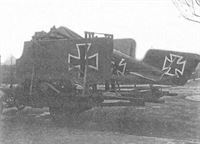 |
J.Herris - Roland Aircraft of WWI /Centennial Perspective/ (9) |
| Transporting a Roland C.IIa to the front by truck from Charlottenburg on November 28, 1916. |
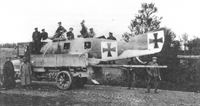 |
J.Herris - Roland Aircraft of WWI /Centennial Perspective/ (9) |
| A dismantled mid-production Roland C.II gets a ride to its next airfield. |
 |
J.Herris - Roland Aircraft of WWI /Centennial Perspective/ (9) |
| A Roland C.II is dismantled for transportation. Moving aircraft by train was very common during WWI because it was more reliable than flying the airplanes to their destination. |
 |
J.Herris - Roland Aircraft of WWI /Centennial Perspective/ (9) |
| Four mid-production C.II aircraft dismantled for transportation. The fixed machine gun for the pilot was fitted to all but the first production batch and required the rollover structure to be redesigned. The ear radiators, clearly visible here, detracted from the streamlined fuselage lines. |
 |
J.Herris - Roland Aircraft of WWI /Centennial Perspective/ (9) |
| Roland D.I and late (large fin) C.IIa airframes being built on November 8, 1916 in the Kaiserdamm factory. |
 |
J.Herris - Roland Aircraft of WWI /Centennial Perspective/ (9) |
| The final Roland production batch of large-tail C.II aircraft under construction at the Kaiserdamm factory. |
 |
J.Herris - Roland Aircraft of WWI /Centennial Perspective/ (9) |
| Completed Roland C.II aircraft in front of the LFG factory ready for delivery. |
 |
J.Herris - Roland Aircraft of WWI /Centennial Perspective/ (9) |
| The nose of the Roland C.II was very streamlined. Even the exhaust manifold was streamlined. Because the crewmen's heads extended above the wing, the pilot had a turn-over struture for protection. |
 |
J.Herris - Roland Aircraft of WWI /Centennial Perspective/ (9) |
| The Roland C.II featured a simple, low-drag landing gear. |
 |
J.Herris - Roland Aircraft of WWI /Centennial Perspective/ (9) |
| The simple wood frame of the Roland C.II was covered by a streamlined, two-part Wickelrumpf shell. |
 |
J.Herris - Roland Aircraft of WWI /Centennial Perspective/ (9) |
| The streamlined interplane strut had internal 'X' bracing connecting the two spars in both wings. |
 |
J.Herris - Roland Aircraft of WWI /Centennial Perspective/ (9) |
| A virtually unknown Roland private venture design of 1915 is this rotary-engine aircraft similar in concept to the C.II. No details are known, not even if it had one or two seats. |
 |
J.Herris - Roland Aircraft of WWI /Centennial Perspective/ (9) |
| The Roland C.II flown by Otto Czernak was equipped with an interesting instrument in the cockpits that enabled the observer to send directions to the pilot. The pilot's receiver is shown behind the control wheel |
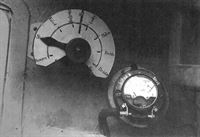 |
J.Herris - Roland Aircraft of WWI /Centennial Perspective/ (9) |
| The Roland C.II flown by Otto Czernak was equipped with an interesting instrument in the cockpits that enabled the observer to send directions to the pilot. Here is a closeup of the sender in the observer's cockpit. The German text and apparent meanings are: Pumpen - Pump (the elevators up and down?), text obscured by arrow, Feind - Enemy, Gleitflug - Glide or cruise slowly, Gut - Good (apparently sent when the pilot was following directions), Links - To the left, Hafen - Head for home, Rechts - To the right, Druckn - Dive. |
 |
J.Herris - Roland Aircraft of WWI /Centennial Perspective/ (9) |
| Wireless installation in the front of the observer's cockpit of a Roland C.II. |
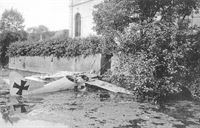 |
J.Herris - Roland Aircraft of WWI /Centennial Perspective/ (9) |
| Flairing for landing too high above ground was not the only way to have a landing accident; this Roland C.II ended its career landing in a canal. |
 |
J.Herris - Roland Aircraft of WWI /Centennial Perspective/ (9) |
| Yet another Roland C.II pilot has misjudged his landing. This is graphic evidence of the absolute need for the rollover pylon to protect the crew in case of an accident, although one wonders if the observer survived. |
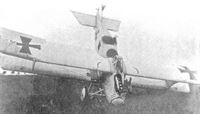 |
J.Herris - Roland Aircraft of WWI /Centennial Perspective/ (9) |
| Still more Roland C.II landing fun. |
 |
Сайт - Pilots-and-planes /WWW/ |
| Roland C.II of Feldflieger Abteilung (A) 292b |
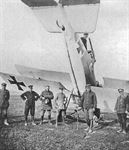 |
J.Herris - Roland Aircraft of WWI /Centennial Perspective/ (9) |
| More Roland C.II landing fun, this time an aircraft of Schusta 6. |
 |
J.Herris - Roland Aircraft of WWI /Centennial Perspective/ (9) |
| Although many WWI aircraft were destroyed in bad landings, the Roland C.II was notorious for being difficult to land due to the poor field of view forward and downward. This early-production C.II of FeldfliegerAbteilung 292b wrecked in a landing accident on April 22, 1916 shows its underside details. The two holes are for the camera and bombs. Although mechanical parts like the engine and machine guns could often be salvaged from a wreck, if the engine was running when the aircraft was wrecked, as evident here by the shattered propeller blades, the crankshaft was typically broken during impact. |
 |
J.Herris - Roland Aircraft of WWI /Centennial Perspective/ (9) |
| Another view of the same Roland C.II landing accident. |
 |
Сайт - Pilots-and-planes /WWW/ |
| Roland C.II of Feldflieger Abteilung (A) 292b |
 |
J.Herris - Roland Aircraft of WWI /Centennial Perspective/ (9) |
| An example of why transportation by train was often preferred; a Roland C.II of Bavarian Kampfstaffel 36 has come to grief in during landing. A shark mouth and eye have been painted on the nose and the wheel covers have been quartered, perhaps in Bavarian blue and white. The light interplane strut and lack of a distinct camouflage pattern indicate the dark camouflage may have been applied at the unit. |
 |
J.Herris - Roland Aircraft of WWI /Centennial Perspective/ (9) |
| Roland C.IIa of Schutzstaffel 27 crashed May 27, 1917. This aircraft is from the final Roland production batch and finally has the large fin needed for greater stability, something the aircraft needed from the beginning. It is camouflaged and has a chevron in front of the fuselage cross; the numeral '1' is in front of the chevron. |
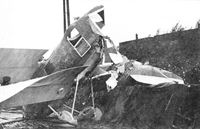 |
J.Herris - Roland Aircraft of WWI /Centennial Perspective/ (9) |
| A Roland C.II wrecked in a landing accident was hardly a rare event; however, this photo is included to show the interesting fish scales painted on the fuselage. The windows could be used as emergency exits when needed. |
 |
J.Herris - Roland Aircraft of WWI /Centennial Perspective/ (9) |
| Closeup of yet another Roland C.II landing debacle showing the need for the rollover pylon. |
 |
J.Herris - Roland Aircraft of WWI /Centennial Perspective/ (9) |
| Taxi accidents are more likely when aircraft have no brakes, and most WWI aircraft lacked brakes. |
 |
Журнал - Flight за 1917 г. |
| The Roland two-seater. |
 |
O.Thetford, P.Gray - German Aircraft of the First World War /Putnam/ |
 |
J.Herris - Roland Aircraft of WWI /Centennial Perspective/ (9) |
| Roland C.II |
 |
J.Herris - Roland Aircraft of WWI /Centennial Perspective/ (9) |
| Roland C.II |
 |
J.Herris - Roland Aircraft of WWI /Centennial Perspective/ (9) |
| Roland C.II |
 |
J.Herris - Roland Aircraft of WWI /Centennial Perspective/ (9) |
| Roland C.II |
 |
В.Кондратьев - Самолеты первой мировой войны |
| "Роланд" C-II |